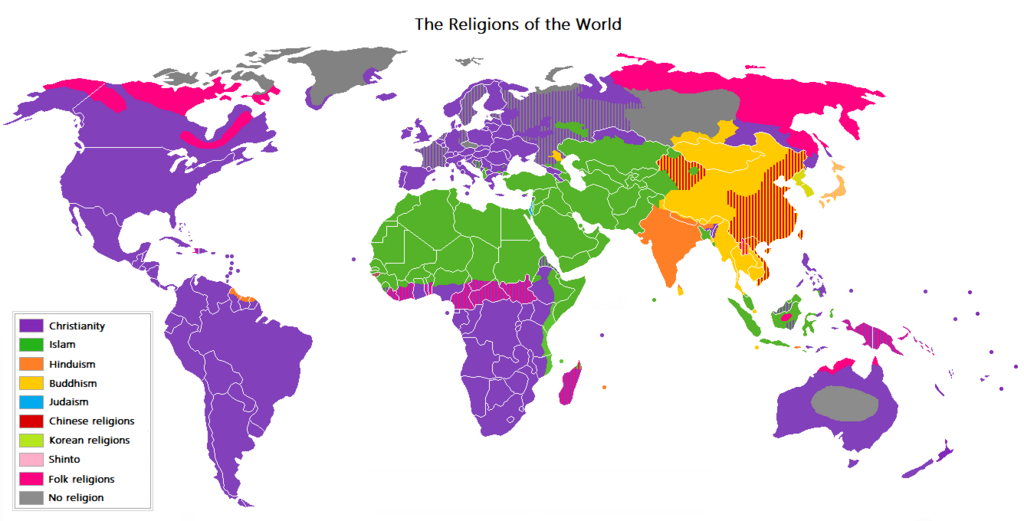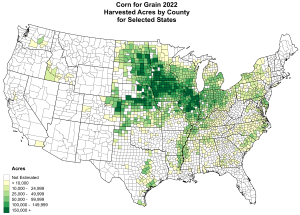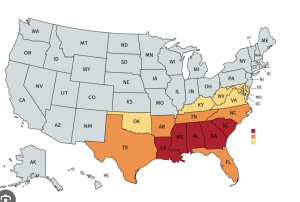Chapter 5. Cultural Patterns and Processes
5.4 Culture Regions
5.4.1 Definition of Culture Region
A culture region is a portion of Earth’s surface that has common cultural elements. Identifying and mapping culture regions are significant tasks because they show us where particular culture traits or cultural communities are located. Maps of culture regions provide answers to that most fundamental geographical question: Where?
The concept of culture region serves roughly the same purpose as that of a historical period. When learning world history, for example, the subject is commonly divided into time segments that might be labeled The Neolithic Revolution, The Cold War Era, and so forth. The purpose of these arbitrary divisions is to make world history more understandable by dividing it into periods that have common themes. Similarly, the purpose of regions – which also are arbitrary – is to make cultural geography more understandable by dividing the world into areas that have something in common (see Chapter 1: Formal, functional and perceptual regions).
Culture regions, like cultures themselves, display considerable variety. For starters, any number of cultural components may be used to define culture regions. A map of world religions, for example, includes a shaded area in South Asia where Hinduism is dominant as shown in Figure 5.4.1. That is a culture region based on a single cultural component, as are each of the other shaded areas on that map.

Source: “Major religions distribution” by Usergreatpower via Wikimedia Commons is in the public domain.
Similarly, on the language map of Europe below (Figure 5.5.), notice between France and Spain the yellow area – this is where Basque is dominant. That also would be a culture region based on a single cultural component. In contrast, if you were researching Japan, you might go down the list of cultural components and characterize the Japanese culture region with respect to religion, language, architecture, cuisine, and so forth. For comparison’s sake, you might then compare that list to the U.S. culture region to the Mexican culture region, or the culture region of some other country.

Source: “Language culture map of Europe” by Andrei Nacu via Wikimedia Commons is licensed under CC BY-SA 3.0.

Source: “Corn harvested acres by county” is in the public domain in the United States because it is a work prepared by an officer or employee of the United States Government as part of that person’s official duties under the terms of Title 17, Chapter 1, Section 105 of the US Code.
Culture regions differ greatly in size. Some are exceedingly large, like the Islamic culture region that encompasses millions of square miles of North Africa and Southwest Asia. Some are very small, like Spanish Harlem, which encompasses about two square miles of Manhattan. Many others are of intermediate sizes, like the Corn Belt, which occupies a portion of the Midwestern United States. When students see the words Hindu culture region, they may logically infer that only Hindus live there. Not so. That region also is home to millions of Muslims, Buddhists, Christians, and other non-Hindus. Similarly, there are some people in Spanish Harlem who do not speak Spanish and some farmers in the Corn Belt who do not grow corn. Culture regions tend to exhibit a certain diversity—their titles identify a dominant characteristic (Hinduism, Spanish, corn) but do not necessarily mean that everybody who lives there shares that characteristic.
5.4.2 Cultural Diversity within Cultural Regions
A great deal of diversity typically exists within a culture region. For example, when studying France, you would discover that Arabs, sub-Saharan Africans, and West Indians comprise large ethnic communities in many cities. This population diversity here has its roots in French colonialism as large swaths of Africa, North and Central, were colonized by France.

Source: Photo by Barbara Crain, CC BY 4.0.
In contrast, in Germany, Turks and various Slavic peoples often are the major minority groups. Turks were actively recruited by the German government to join the workforce in the 1960s and beyond; they were the famous Gastarbeiter, guest workers. Workers that were asked to come and work and then leave again after a year or so. It was expected that they leave their family in Turkey; integration into German society was also not considered. For example, no German classes were offered. However, many Gastarbeiter stayed and eventually brought their families over as well. In the 1980s it became noticeable that ‘German as a Second Language’ classes needed to be offered to help integration into German culture.
Slavic people in Germany have their roots in post-World War II as many of them came as refugees fleeing the Iron Curtain.

Source: “Residências by Hugo Martins via Flickr is licensed under CC BY-NC 2.0.
Urban fringes the world over also exhibit cultural differences. The typical American suburb exhibits housing, land use, and lifestyles that differ significantly from what is observed on the periphery of cities in West Africa or Central America, for example (see Figure 5.4.5 and 5.4.6)

Source: “American Suburbia” by Christopher Chappelear via Flickr is licensed under CC BY 2.0.

Source: Photo by Barbara Crain, CC BY 4.0.
Rural parts of the world may differ on the basis of language, religion, or some other cultural component— most notably agriculture. Thus, dairy farming and apple growing characterize different sections of rural New York State (see Figure 5.4.7). Both are visually distinctive and may be thought of as separate culture regions. In contrast, rural culture regions elsewhere in the world might be dominated by cattle ranches, rice fields, banana plantations, or some other form of agriculture.

Source: “Early Localization Native Americans USA” by William C. Sturtevant, Smithsonian Institute is in the public domain in the United States because it only contains materials that originally came from the United States Geological Survey, an agency of the United States Department of the Interior.
Change in cultural regions can be seen everywhere. In the course of subsequent migrations different peoples occupied different parts of the continent. Thus, by 1492 North America was a mosaic of Native American culture regions. Many of them have since disappeared or have diminished in size (Figure 5.4.8). Much more recently, there are lots of areas and neighborhoods in New York State and elsewhere that are experiencing ethnic change—a situation in which one cultural community is expanding or contracting in opposition to another.

Source: “The South and Deep South” by TheFrenchTickler1031 via Wikimedia Commons is licensed under CC BY-SA 4.0.
This highlights the fact that culture unites and divides humanity: while it instills a sense of unity among some peoples, it creates differences (perhaps deep animosities) between others. Accordingly, maps of culture regions may provide important perspectives on contemporary problems that are rooted in cultural differences. For example, you may agree with the map of the American South in Figure 5.4.9 or you may not.

